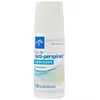What's inside
What's inside
 Key Ingredients
Key Ingredients

No key ingredients
 Benefits
Benefits

 Concerns
Concerns

 Ingredients Side-by-side
Ingredients Side-by-side

Water
Skin ConditioningAluminum Chlorohydrate
AstringentSteareth-2
EmulsifyingCeteareth-12
EmulsifyingStearyl Alcohol
EmollientCeteareth-20
CleansingDistearyl Ether
Skin ConditioningDimethicone
EmollientCetearyl Dimethicone
EmollientCetearyl Dimethicone Crosspolymer
Glycerin
HumectantSucrose Dilaurate
EmollientPolysorbate 20
EmulsifyingPisum Sativum Extract
Skin ConditioningParfum
MaskingButylene Glycol
HumectantBee Venom
AstringentDimethyl Phenylbutanol
MaskingHamamelis Virginiana Water
AstringentPhenoxyethanol
PreservativeEthylhexylglycerin
Skin ConditioningHydrolyzed Prunus Domestica
Skin ConditioningKojic Acid
AntioxidantAcetyl Tyrosine
Skin ConditioningSodium Sulfite
PreservativeAminopropyl Ascorbyl Phosphate
AntioxidantPaeonia Suffruticosa Root Extract
Skin ProtectingSaxifraga Sarmentosa Extract
Skin ConditioningScutellaria Baicalensis Root Extract
AstringentGlutathione
Tetrasodium EDTA
Bisabolol
MaskingWater, Aluminum Chlorohydrate, Steareth-2, Ceteareth-12, Stearyl Alcohol, Ceteareth-20, Distearyl Ether, Dimethicone, Cetearyl Dimethicone, Cetearyl Dimethicone Crosspolymer, Glycerin, Sucrose Dilaurate, Polysorbate 20, Pisum Sativum Extract, Parfum, Butylene Glycol, Bee Venom, Dimethyl Phenylbutanol, Hamamelis Virginiana Water, Phenoxyethanol, Ethylhexylglycerin, Hydrolyzed Prunus Domestica, Kojic Acid, Acetyl Tyrosine, Sodium Sulfite, Aminopropyl Ascorbyl Phosphate, Paeonia Suffruticosa Root Extract, Saxifraga Sarmentosa Extract, Scutellaria Baicalensis Root Extract, Glutathione, Tetrasodium EDTA, Bisabolol
Ingredients Explained
These ingredients are found in both products.
Ingredients higher up in an ingredient list are typically present in a larger amount.
Aluminum Chlorohydrate has astringent, deodorant, antiperspirant, and water purifying properties.
Due to its astringent properties, this ingredient may be drying.
Aluminum chlorohydrate is one of the most common active ingredients found in antiperspirants. It works by temporarily blocking sweat ducts, reducing the amount of sweat that reaches the surface of the skin.
Despite its long history of use, rumors and misconceptions about aluminum chlorohydrate persist.
Scientific consensus and major health organizations have repeatedly concluded that aluminum chlorohydrate, when used as directed in cosmetic products like antiperspirants, is safe.
The persistent rumors connecting aluminum chlorohydrate to cancer, Alzheimer’s disease, or “toxin buildup” are not supported by credible evidence.
If you’re comfortable with aluminum-based antiperspirants, there is no scientifically backed reason to fear them.
If you prefer to avoid them, plenty of aluminum-free options exist - but that choice usually comes down to personal preference rather than proven health risks.
Learn more about Aluminum ChlorohydrateGlycerin is already naturally found in your skin. It helps moisturize and protect your skin.
A study from 2016 found glycerin to be more effective as a humectant than AHAs and hyaluronic acid.
As a humectant, it helps the skin stay hydrated by pulling moisture to your skin. The low molecular weight of glycerin allows it to pull moisture into the deeper layers of your skin.
Hydrated skin improves your skin barrier; Your skin barrier helps protect against irritants and bacteria.
Glycerin has also been found to have antimicrobial and antiviral properties. Due to these properties, glycerin is often used in wound and burn treatments.
In cosmetics, glycerin is usually derived from plants such as soybean or palm. However, it can also be sourced from animals, such as tallow or animal fat.
This ingredient is organic, colorless, odorless, and non-toxic.
Glycerin is the name for this ingredient in American English. British English uses Glycerol/Glycerine.
Learn more about GlycerinParfum is a catch-all term for an ingredient or more that is used to give a scent to products.
Also called "fragrance", this ingredient can be a blend of hundreds of chemicals or plant oils. This means every product with "fragrance" or "parfum" in the ingredients list is a different mixture.
For instance, Habanolide is a proprietary trade name for a specific aroma chemical. When used as a fragrance ingredient in cosmetics, most aroma chemicals fall under the broad labeling category of “FRAGRANCE” or “PARFUM” according to EU and US regulations.
The term 'parfum' or 'fragrance' is not regulated in many countries. In many cases, it is up to the brand to define this term.
For instance, many brands choose to label themselves as "fragrance-free" because they are not using synthetic fragrances. However, their products may still contain ingredients such as essential oils that are considered a fragrance by INCI standards.
One example is Calendula flower extract. Calendula is an essential oil that still imparts a scent or 'fragrance'.
Depending on the blend, the ingredients in the mixture can cause allergies and sensitivities on the skin. Some ingredients that are known EU allergens include linalool and citronellol.
Parfum can also be used to mask or cover an unpleasant scent.
The bottom line is: not all fragrances/parfum/ingredients are created equally. If you are worried about fragrances, we recommend taking a closer look at an ingredient. And of course, we always recommend speaking with a professional.
Learn more about ParfumPolysorbate 20 is made by combining ethoxylation of sorbitan, ethylene oxide, and lauric acid. It is a mild cleansing agent, surfactant, and emulsifier.
As a surfactant, it helps collect dirt and oils for washing. Emulsifiers prevent oils and water from separating.
Polysorbate 20 also adds scent to a product. Since it is made using sorbitol, it has a sweet scent. Sorbitol can also be found in fruits such as apples and peaches.
The lauric acid used to create Polysorbate 20 is often derived from coconuts.
Polysorbate 20 may not be fungal acne safe.
Learn more about Polysorbate 20Tetrasodium EDTA is the salt formed from neutralizing ethylenediamine tetraacetic acid with sodium hydroxide. It is a chelating agent and used to prevent metal ions from binding to other ingredients. This helps keep the product and ingredients stable.
Tetrasodium EDTA comes as a white solid and is soluble in water.
Water. It's the most common cosmetic ingredient of all. You'll usually see it at the top of ingredient lists, meaning that it makes up the largest part of the product.
So why is it so popular? Water most often acts as a solvent - this means that it helps dissolve other ingredients into the formulation.
You'll also recognize water as that liquid we all need to stay alive. If you see this, drink a glass of water. Stay hydrated!
Learn more about Water